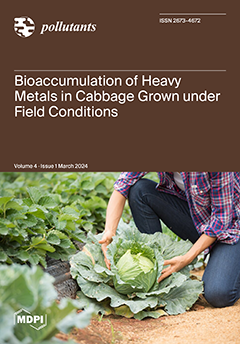This study presents a comprehensive assessment of indoor particulate matter (PM) concentrations, focusing on PM
1, PM
2.5, and PM
10 in five primary health centers (PHCs): Arakale (Urban), the Federal College of Agriculture (FECA) (Urban), Iju (semi-urban), Oba-Ile (semi-urban), and
[...] Read more.
This study presents a comprehensive assessment of indoor particulate matter (PM) concentrations, focusing on PM
1, PM
2.5, and PM
10 in five primary health centers (PHCs): Arakale (Urban), the Federal College of Agriculture (FECA) (Urban), Iju (semi-urban), Oba-Ile (semi-urban), and Owode (Rural) within Akure local government areas in Nigeria. The primary novelty of this research lies in its detailed exploration of the toxicity potential of these PM fractions, providing valuable insights into the local air quality and associated health risks. This study assesses the health implications by calculating the toxicity potential (TP), relative risk (RR), excess risk (ER), and attributable fractions (Afs) for cardiopulmonary and lung cancer mortality. The results reveal varying RR values for all-cause mortality, with Arakale showing a slight elevation (RR: 1.061), indicating potential health risks. ER values for cardiopulmonary mortality range from 14.728 ± 7.25 to 19.04 ± 0.38, emphasizing the substantial excess risk associated with long-term PM
2.5 exposure. The study also uncovers Afs for cardiopulmonary mortality ranging between 11.03 ± 0.31 and 19.22 ± 0.04, underscoring the significant contribution of PM to cardiovascular and respiratory health risks. Similarly, Afs for lung cancer mortality range from 10.03 ± 0.012 to 17.13 ± 0.10, highlighting the substantial association between PM
2.5 exposure and lung cancer risk. These findings underscore the urgent need for targeted air quality management strategies and public health interventions in the studied locations to mitigate the heightened health risks associated with particulate matter pollution. The calculated RR, ER, and AF values offer crucial insights into the complex relationship between PM exposure and adverse health outcomes, providing a foundation for informed decision-making and future research endeavors.
Full article



